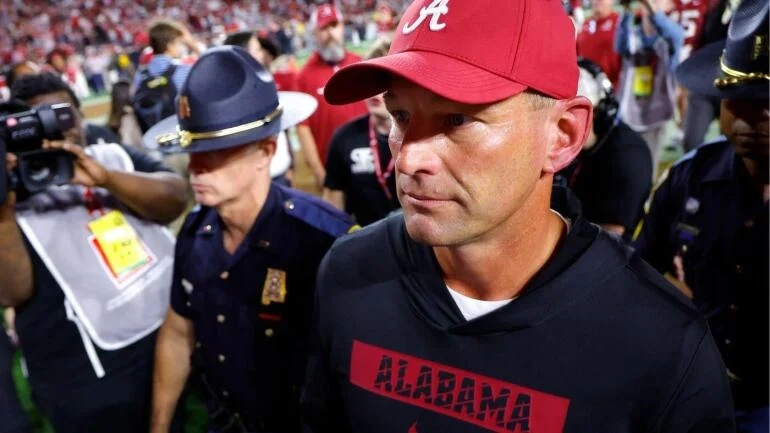In Tuscaloosa, expectations are measured in championships—not division titles, not playoff appearances, but rings and parades. That’s the standard Nick Saban built over his dynastic run at Alabama, and that’s the standard Kalen DeBoer must now live up to as the Crimson Tide’s head coach in 2025. After a rollercoaster debut campaign that saw moments of brilliance clouded by inconsistency and missed opportunity, the former Washington Huskies head coach enters Year 2 with a sharpened focus, a fortified roster, and perhaps most importantly, a shot at redemption. The question facing DeBoer and Alabama isn’t just whether they’ll be good—it’s whether they’ll be great again.
The Crimson Tide open the 2025 season facing the pressure cooker of lofty expectations and the unforgiving glare of national scrutiny. After falling short in last season’s College Football Playoff semifinal against Texas, Alabama finds itself in a rare position: contender, but not consensus favorite. Georgia has emerged as the new gold standard in the SEC, and teams like Michigan, Ohio State, Oregon, and Florida State continue to stockpile talent and momentum. Yet amid the noise and crowded field, Alabama remains very much in the hunt, carrying a win total over/under set by sportsbooks at 10.5—an aggressive but not unfounded number given the talent and coaching infrastructure in place.
The roster DeBoer has assembled for 2025 is a potent mix of experienced returners and blue-chip newcomers. The offense will once again be helmed by quarterback Jalen Milroe, whose development in Year 2 under DeBoer’s staff is the linchpin of Alabama’s playoff hopes. Milroe flashed elite arm talent and dangerous mobility last season but also showed bouts of inconsistency under pressure. He returns with a stronger grasp of the offensive system and a more defined leadership role in the locker room. If he can cut down on turnovers and improve his intermediate accuracy, the ceiling for this offense is sky-high.
Milroe won’t be short on help. The running back room, led by Justice Haynes and Richard Young, is loaded with power, speed, and depth. Both backs are capable of breaking off explosive plays, and their development as pass-catchers adds another layer of unpredictability to the playbook. At receiver, Alabama is flush with talent. Five-star freshman phenom Ryan Williams—the dynamic early enrollee who lit up spring practice—is expected to make an immediate impact. Returning wideouts Kendrick Law and Isaiah Bond provide experience, speed, and playmaking ability. Tight end Amari Niblack is a matchup nightmare in the red zone and could emerge as one of the SEC’s top pass-catching tight ends.
Up front, Alabama’s offensive line will be the focus of intense scrutiny. Last year’s unit was plagued by inconsistency in both run blocking and pass protection. But reinforcements have arrived. The Crimson Tide added former five-star tackle Kadyn Proctor back via the transfer portal after a one-year stint at Iowa, and the return of Tyler Booker gives them an All-American candidate anchoring the interior. If the offensive line jells early, Milroe’s play will likely rise with it.
Defensively, the Tide remain stacked—albeit with some questions to answer in the secondary following the departure of standout cornerback Kool-Aid McKinstry and safety Malachi Moore to the NFL. That said, the defensive line may be the best unit on the team. Five-star defensive tackle James Smith looks ready to take on a starring role after a dominant spring, and edge rusher Keon Keeley could finally be primed for the breakout that fans have long anticipated. Linebacker Deontae Lawson returns as the heart and soul of the defense, bringing with him a sideline-to-sideline presence and vocal leadership.
The secondary is where DeBoer’s staff must earn their paycheck. Replacing the experience and versatility of Moore and McKinstry is no small feat, but the staff is high on young corners Jahlil Hurley and Domani Jackson, a former USC transfer with elite athleticism and physicality. Safety play will be a question mark early in the season, though transfer help and talented freshmen provide options if the projected starters struggle.
Special teams, often overlooked, could be an area of quiet strength. Kicker Will Reichard is gone, but freshman phenom Graham Oliver—who was rated as the top kicking prospect in the country—could be a worthy successor. Punter James Burnip returns for his fifth year, providing stability and field position control in close games.
The schedule for Alabama in 2025 is grueling but manageable. Home games against Georgia, Auburn, and South Carolina provide marquee moments inside Bryant-Denny Stadium, while road tilts at Oklahoma and LSU will define the season. Alabama opens the year with a neutral-site showdown against Wisconsin in Atlanta—a game that could set the tone for the entire campaign. With the SEC no longer split into divisions under the new 16-team format, every conference game has playoff implications.
The 12-team College Football Playoff format introduces a new layer of strategy and opportunity. In theory, a two-loss Alabama team could still earn a bid, especially if it scores a signature win over Georgia or runs the table after a mid-season stumble. But inside the Mal Moore Football Facility, the goal isn’t to sneak into the playoff—it’s to win it all. Anything less would feel like a failure to a fan base that’s grown accustomed to confetti and trophies.
For Kalen DeBoer, this season represents more than just another year at the helm—it’s his shot at silencing doubters and putting his own stamp on Alabama’s legacy. The transition from Nick Saban to DeBoer was always going to be judged in championship terms, and while his first season earned a solid B+, it also exposed gaps in game management, in-game adjustments, and defensive resilience against elite opponents. Year 2 must show growth. He has the talent, the resources, and the staff. Now comes the hard part: delivering.
Much of DeBoer’s national reputation was built on his ability to maximize quarterback play and offensive efficiency. At Washington, he turned Michael Penix Jr. into a Heisman finalist and led the Huskies to the national title game. At Alabama, he has more talent at every position—but also more pressure. He’s now learning what every Crimson Tide coach since Bear Bryant has faced: winning isn’t enough unless you win it all.
There’s also the psychological element of rebounding after disappointment. The semifinal loss to Texas still lingers in the minds of players and coaches alike. It wasn’t just that Alabama lost—it was how they lost: unable to contain the Longhorns’ vertical passing attack and failing to execute in crunch time. That memory could be the fuel DeBoer needs to motivate his team into becoming sharper, tougher, and more disciplined.
Perhaps the most intriguing subplot of the season is how Alabama fans will respond if the team hits early adversity. Will they rally around DeBoer, recognizing the challenges of replacing a living legend? Or will the seat begin to warm if another two-loss season ends without a trophy? The reality is that DeBoer doesn’t get a long leash. This is Alabama. Every season is a referendum.
Still, there are plenty of reasons to believe 2025 could be the year the Crimson Tide rise again. The offense has more continuity and firepower. The defense, while younger in spots, has the potential to be dominant in the front seven. The special teams are stable. The schedule, while brutal, is lined with opportunities for statement wins. Most of all, DeBoer has had a full offseason to shape the program in his vision, install his culture, and correct the missteps from Year 1.



